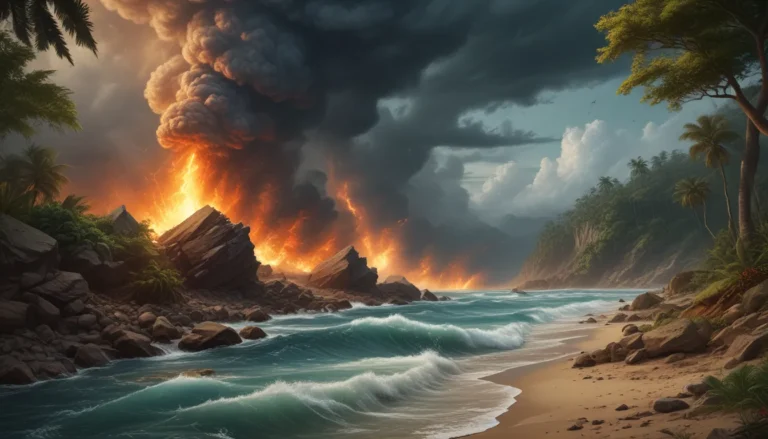A Note About Images: The images used in our articles are for illustration purposes only and may not exactly match the content. They are meant to engage readers, but the text should be relied upon for accurate information.
Are you ready to plunge into the captivating realm of bathymetry? Bathymetry, the study and mapping of the ocean floor’s depths and contours, unveils a world of hidden wonders beneath the sea surface. This vital field of study allows us to comprehend the intricate topography and features concealed beneath the waves.
In this educational journey, we will uncover 10 mesmerizing facts about bathymetry that will leave you awe-inspired and hungry for more knowledge. From the vast expanses of the oceans to the remarkable discoveries made possible through advanced mapping technologies, prepare to be amazed by the secrets lying beneath the ocean’s surface.
So, gear up and join us in unraveling the mysteries of the ocean floor with these intriguing bathymetry facts!
Illuminating Insights:
- Bathymetry enables scientists to map the ocean floor, unveiling hidden treasures like underwater volcanoes and sunken shipwrecks. It’s akin to creating a colossal treasure map for the sea.
- By analyzing bathymetric data, scientists can decode ocean currents, mitigate tsunami hazards, and even explore iconic locations like the Great Barrier Reef. It’s like piecing together a grand puzzle to reveal the secrets of the deep blue sea!
The Mariana Trench: The Ocean’s Deepest Point
Bathymetry, through the measurement of ocean depths and seafloor topography, has identified the Mariana Trench as the world’s deepest point. Situated in the western Pacific Ocean, this trench plunges to a staggering depth of approximately 36,070 feet (10,994 meters) below sea level.
Charting the Seafloor
Bathymetry plays a pivotal role in mapping the seafloor, enabling scientists to comprehend the intricate features and formations beneath the ocean’s surface. Utilizing specialized sonar systems and satellite technology, bathymetric data is collected to craft accurate maps of the ocean floor.
Discovery of Submerged Mountain Ranges
Bathymetry has unveiled extensive submerged mountain ranges called mid-ocean ridges. These underwater mountain chains, spanning thousands of kilometers, offer valuable insights into plate tectonics and the genesis of new oceanic crust.
Unmasking Underwater Volcanoes
Bathymetric surveys have exposed numerous underwater volcanoes, known as seamounts, lurking beneath the ocean’s surface. These volcanic structures play a pivotal role in nurturing unique ecosystems and influencing ocean currents and water chemistry.
Mapping Oceanic Trenches
Bathymetry has empowered scientists to accurately map the intricate details of oceanic trenches. These vast depressions in the seafloor, formed by tectonic plate collisions, harbor diverse marine life, including species adapted to extreme conditions.
Deciphering Ocean Circulation
Through the scrutiny of bathymetric data, scientists have enhanced their understanding of global ocean currents. The shape and depth of the seafloor dictate water flow, impacting climate patterns and the dispersion of heat and nutrients in the ocean.
Revealing Underwater Canyons
Bathymetry has unveiled the existence of underwater canyons that rival their terrestrial counterparts in size and complexity. Submarine canyons, such as the Monterey Canyon off the coast of California, provide vital habitats for marine life and serve as conduits for sediment transport.
Exploration of the Great Barrier Reef
Bathymetry has been instrumental in exploring and mapping the Great Barrier Reef, the world’s largest coral reef system. Through bathymetric data analysis, scientists can pinpoint shallow areas, coral formations, and intricate reef structures, aiding conservation efforts and enhancing understanding of the reef’s ecological significance.
Locating Sunken Shipwrecks
Bathymetry has facilitated the location and study of sunken shipwrecks. By employing sonar technology and detailed bathymetric maps, researchers can precisely identify these maritime relics, shedding light on historical events and offering insights into marine archaeology.
Unraveling Tsunami Hazards
Bathymetric data plays a crucial role in understanding the potential repercussions of tsunamis. By scrutinizing the seafloor’s shape and features, scientists can model tsunami propagation accurately, predicting areas susceptible to tsunami inundation and aiding in mitigating the risks posed by these formidable natural disasters.
These captivating facts about bathymetry underscore its pivotal role in elucidating the mysteries of the ocean. From delineating underwater mountain ranges to uncovering sunken shipwrecks, bathymetry continues to provide invaluable insights into the dynamic world beneath the waves.
In Conclusion
In essence, bathymetry stands as a riveting and indispensable field of study that has significantly enriched our comprehension of the world’s oceans and their hidden depths. By exposing intricate seafloor landscapes, mapping underwater volcanoes and trenches, bathymetry contributes substantially to various scientific and practical endeavors.
By leveraging advanced technologies and methodologies, scientists forge ahead in expanding our knowledge of the underwater realm. By delving into the enigmas of bathymetry, we unearth valuable insights into Earth’s geological history, monitor oceanic changes and phenomena, ensure safe navigation for maritime vessels, and tap into unexplored resources beneath the ocean floor.
The ever-evolving domain of bathymetry promises a plethora of new discoveries, destined to astonish and captivate us as we continue to unravel the secrets of the ocean’s depths.
FAQs
-
What is bathymetry?
Bathymetry is the scientific study of the depth, topography, and features of the ocean floor, encompassing the measurement and mapping of underwater landscapes using diverse techniques and instruments. -
How is bathymetry data collected?
Bathymetry data can be collected through methods such as sonar, multibeam echo sounders, satellite altimetry, and remote sensing, utilizing sound waves, satellite technology, and specialized devices to measure seafloor depth and shape. -
What are the practical applications of bathymetry?
Bathymetry finds myriad practical applications, including facilitating safe navigation for ships, aiding offshore construction and infrastructure development, exploring marine resources, conducting geological and oceanographic research, and managing environmental concerns. -
Why is bathymetry important?
Understanding ocean bathymetry is crucial for identifying potential hazards such as submerged reefs or volcanic activity, studying ocean currents and tidal movements, and unveiling hidden marine ecosystems and biodiversity. -
How does bathymetry contribute to our understanding of Earth’s history?
By scrutinizing bathymetry, scientists can unearth evidence of past geological events like plate tectonics, volcanic eruptions, and underwater landslides, enriching our comprehension of Earth’s history and aiding in the prediction of future geological phenomena.
Journey with Us
Our commitment to delivering enriching and authentic content lies at the core of our endeavors. Each fact shared on our platform is contributed by real users like yourself, bringing a diverse array of insights and information to light. Rest assured that our dedicated editors meticulously review each submission to ensure the highest standards of accuracy and reliability.
Embrace our pledge to quality and authenticity as you embark on an exploration of knowledge and discovery with us. We invite you to delve deeper into the mysteries of bathymetry and unveil the wonders that await beneath the ocean’s surface.






